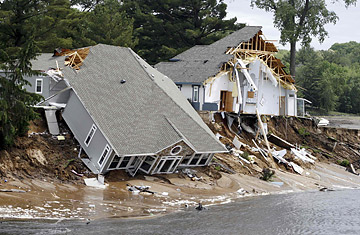
Homes near Lake Delton, Wis., collapsed after heavy rains broke the man-made lake's dam
For days, the American Midwest has endured bands of slow-moving thunderstorms that have unleashed massive tornadoes and caused dams to fail. At least four people were killed as a tornado tore through a Boy Scout camp in the remote hills of western Iowa Wednesday. An entire Wisconsin lake has emptied. Carp are swimming through suburban Milwaukee streets. An Iowa farmer has drowned in his own field. And the havoc is expected to continue, with more bizarre weather and even an alert about a mini-tsunami on Lake Michigan in Chicago. What next? Twisters down Michigan Avenue? Don't scoff.
Last weekend, tornadoes swept through Cook County, which includes Chicago. As a barbecue began on this city's North Side Saturday afternoon, the sky turned the color of charcoal and the wind quickened. One man burst through a door announcing that a tornado had been reported nearby. "Whatever," another man said dismissively, holding a Corona, before adding, "We can't get tornadoes here." Not so. Major cities with skyscrapers aren't less vulnerable to tornadoes than rural, flat areas. Consider the tornadoes that swept through downtown Atlanta and parts of New Orleans earlier this year, and the series of deadly tornadoes that battered Salt Lake City, Nashville and Miami in the late 1990s. "They're a very rare event," Jim Keeney, meteorologist at the National Weather Service's Kansas City, Mo., office, said of urban tornadoes. But, he explains, tornadoes form at an atmospheric level far above skyscrapers like Chicago's iconic Sears Tower. So tall buildings don't prevent their formation in cities.
Part of the blame for the regional atmospheric eccentricities, experts say, lies with La Niña: cool oceanic surfaces in the Pacific that generally produce wetter springs and early summers in the Midwest than El Niño would. The country is now in the middle of a three-year La Niña period. That explains the fierce rain that has battered central Midwestern states like Missouri, Illinois and Iowa. Flooding in Iowa's southeastern corner has been particularly pronounced this year, as it was last summer, mainly because bands of thunderstorms have stubbornly hovered above already-saturated corn and soybean fields. This year, however, the storms have extended farther north, into Wisconsin and Minnesota, and farther south, into Oklahoma and Arkansas.
But does La Niña explain another odd incident that came about at 3:52 p.m. Sunday? At that moment, the National Weather Service issued a seiche warning for Lake Michigan, near Chicago: "Public reports of a drop in Lake Michigan water level at Chicago by 2 feet in the last hour indicates that a seiche is affecting the water levels of Lake Michigan." Many people had never even heard of a seiche, so no one paid attention—until the Chicago Tribune splashed headlines about it the next day. A seiche (pronounced saysh) occurs when an approaching thunderstorm pushes water away from a large enclosed body of water's shorelines. But after the storm passes, the water swiftly returns in the form of a wave. Sort of like a tsunami. Last weekend's Lake Michigan seiche occurred over a roughly 60-min. period and was not noticeable to the untrained eye. But now seiches have entered into the Windy City's vocabulary of weather apocalypse.
One of the biggest threats seiches pose is to people walking on piers: surging water may sweep them away. That's what happened on June 26, 1954, when a 10-foot seiche swept eight Chicago fishermen away in what meteorologists say remains the most destructive seiche recorded here. The Great Lakes are particularly vulnerable to seiches because they are the largest enclosed bodies of water in the U.S. Edward Fenelon, an NWS meteorologist in Romeoville, Ill., however, says fewer than three seiches are reported at each of the Great Lakes each year.
Meanwhile, on late Sunday, Wisconsin governor Jim Doyle declared a state of emergency. National Guard troops were dispatched to severely flooded areas. More than 100 roads, many with significant structural damage, were closed. Doyle swiftly ordered the inspection of his state's roughly 3,500 dams. So far, 13 dams have been destroyed and water is seeping through several others. "It's a full-scale response," Doyle told TIME this week. "We're thankful that, despite all the physical damage, nobody lost their lives."
Federal Emergency Management Agency officials are expected to arrive Thursday to assess the damage. One area likely to get particular attention is Lake Delton, Wis., about a three-hour drive west of Chicago. Residents of the popular resort community watched the lake's level rise 51 inches above its usual 12 feet between Friday and Sunday. Volunteers filled sandbags, and by dawn Monday, the sun was shining. "We were in waiting mode, hoping to see the water go down," says Tom Diehl, general manager and co-owner of the Tommy Bartlett Show, a circus-like variety show popular with Midwestern families. But the water kept rising, saturating the land around the lake. Eventually, it collapsed, Diehl says, "right before our eyes." Diehl is hoping to reopen the show this weekend. But his worries are hardly over: storms are expected to batter the region in the coming days.
